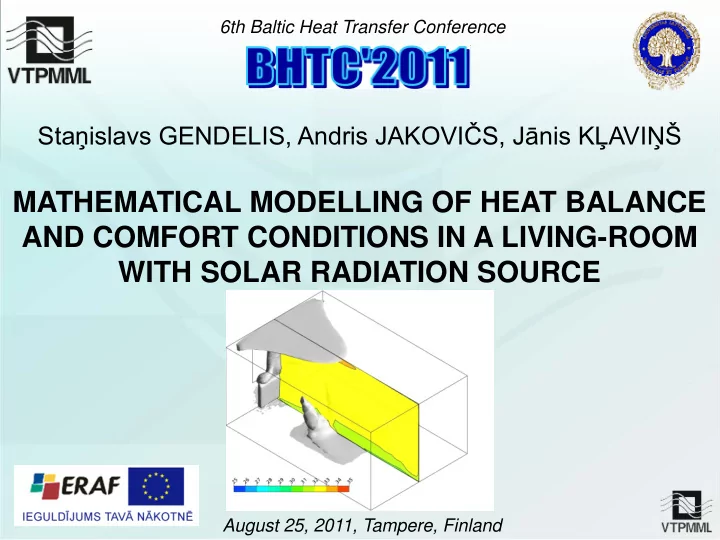

6th Baltic Heat Transfer Conference Sta ņ islavs GENDELIS, Andris JAKOVI Č S, J ā nis K Ļ AVI Ņ Š MATHEMATICAL MODELLING OF HEAT BALANCE AND COMFORT CONDITIONS IN A LIVING-ROOM WITH SOLAR RADIATION SOURCE August 25, 2011, Tampere, Finland
GENERAL PROBLEM FORMULATION Living room with window and heater Sun is shining through the window 2. Thermal comfort conditions 1. Heat balance of the room
GEOMETRY, BOUNDARY CONDITIONS 6 m heat transfer, convection, heat transfer, 15 ° C convection, -10 ° C 2,75 m solar radiation, 4 m surface temperature, 500 W/m 2 50 ° C heat transfer, convection, 20 ° C
SOLAR RADIATION IN LATVIA, 2009
1. HEAT BALANCE OF THE ROOM Conduction heat losses Convection heat losses Solar heat source Internal heat sources
2. HUMAN THERMAL COMFORT CONDITIONS • Temperatures T • Vertical temperature difference Δ T, Category of thermal radiant temperature asymmetry environment A , B , C • Air velocity v • Other factors v Δ T T
CATEGORY OF THERMAL COMFORT CONDITIONS (EN ISO 7730) Operative Radiant Vertical air Floor surface Air Category temperature, temperature temperature temperature, velocity, °C asymmetry, °C difference, °C °C cm/s 22.0*±1.0 <10 <2 19-29 <10* A 22.0*±2.0 <10 <3 19-29 <16* B 22.0*±3.0 <13 <4 17-31 <21* C * in winter season, at activity of 70 W/m 2 . Generally depends on metabolic rate.
3D MODELLING, DISCRETISATION For numerical calculations software Ansys/CFX is used with traditional differential equations: • Reynolds averaged momentum equation ( v, p ) ; • continuity equation; • energy conservation equation ( T ) ; • SST ( k- ω ) turbulence model. Size of elements: from 0,5 mm till 10 cm . 500000+ elements.
MODELLING VARIANTS Variants Variants Variants Variants Variants Variants Properties Properties Properties Properties Properties Properties N N N N N 60 60 60 60 45 45 45 30 30 45 Angle of attack α (degrees) Angle of attack α (degrees) Angle of attack α (degrees) Angle of attack α (degrees) Angle of attack α (degrees) Angle of attack α (degrees) - - - - - 60 60 60 60 45 45 45 30 30 45 Boundary condition on heater Boundary condition on heater Boundary condition on heater Boundary condition on heater Boundary condition on heater Boundary condition on heater temperature, 50°C temperature, 50°C temperature, 50°C temperature, 50°C temperature, 50°C adiabatic Heat amount for the heater (W) Heat amount for the heater (W) Heat amount for the heater (W) Heat amount for the heater (W) Heat amount for the heater (W) Heat amount for the heater (W) 225 225 225 225 225 173 173 173 173 173 173 173 178 178 0 Solar power W Solar power W Solar power W Solar power W Solar power W Solar power W 0 0 0 0 0 411 411 411 411 327 327 327 228 228 333
1. RESULTS: HEAT BALANCE OF THE ROOM N 60 45 30 A
2. RESULTS: COMFORT CONDITIONS N 60 45 30 A
MODELLING VARIANTS: RESULTS Results N 60 45 30 A Maximum mean air velocity v (cm/s) 4 7 8 7 5 Average temperature T ( ° C) 24.2 32.5 30.8 28.4 26.0 Radiant temperature asymmetry ( ° C) 9 10 10 8 12 Vertical temperature difference ∆ T ( ° C) 2.0 1.6 1.6 1.4 2.4 Floor surface temperature ( ° C) 22 29 27 25 31 Category of thermal environment [EN ISO 7730] A C A B A
VISUALIZATION. TEMPERATURE without solar source with 45° solar source
VISUALIZATION. AIRFLOWS without solar source with 45° solar source
VISUALIZATION. TEMPERATURE with 60° solar source with 30° solar source
VISUALIZATION. AIRFLOWS with 60° solar source with 30° solar source
VISUALIZATION. TEMPERATURE without solar source without heater 50 ° C ave =24 ° C ave =26 ° C T T
VISUALIZATION. AIRFLOWS without solar source without heater
EXAMPLES OF TEMPERATURE ISOSURFACES without solar source, 25 °C with 45° solar source, 32 °C
CONCLUSIONS � The numerical modelling allows estimation of: � heating consumption of the room, � the temperature field, airflow distribution and the tendencies of its changes. � Solar radiation source is very important factor. It has to be included in the numerical simulations to predict the heat balance and comfort conditions more accurately. � The use of numerical calculations for the room at design stage allows to � optimize the heat balance and reduce heat losses, � predict the category of thermal environment for different building types.
Recommend
More recommend